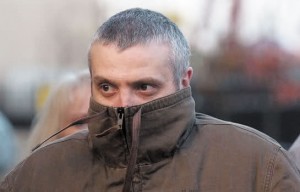Brian Rowan

Mark Haddock rende il processo diverso – diverso perché c’è una storia dietro la sua storia, pagine e capitoli che scrutano nello Special Branch e nella “guerra sporca”.
Haddock è stato un CHIS (Covert Human Intelligence Source – Fonte di Notizie sotto Copertura), pagato decine di migliaia di sterline dallo Special Branch quando era nel loro libro paga.
Quattro anni fa, al termine di un’indagine conosciuta come Operation Ballast, il Police Ombudsman pubblicò un rapporto di 160 pagine.
Il nome di Haddock non figurava nel documento. Veniva identificato solo come “Informatore 1”, e l’indagine registrava il suo presunto coinvolgimento in 10 omicidi, tra cui l’uccisione di Tommy English, avvenuta il 31 ottobre 2000 nel corso di una faida lealista.
C’era un’altra informazione che collegavano l’informatore dello Special Branch a tutta una serie di altri crimini.
E, così, quando Haddock è finito sotto i riflettori, è accaduto lo stesso a chi, nel mondo degli informatori, lo ha gestito e pagato.
Questo processo ci fa pensare ancora una volta agli angoli bui di quella guerra sporca, ci fa riflettere su quanto sporca fosse davvero.
In una conversazione con me, un ex alto ufficiale dello Special Branch una volta ha descritto la UVF come “una vile, sporca, pericolosa e mortale organizzazione”. Ha spiegato: “Siamo dovuti entrare tra di loro.
“Quando inizi a mischiarti con essa, finisci per sporcarti”.
Haddock, mi ha riferito l’ex funzionario dello Special Branch, “era una fonte in esercizio”. Disse: “Ci sarebbe stata molta più gente nei cimiteri del Nord se non avessimo arruolato gente come Mark Haddock”.
Con l’avvicinarsi del processo, martedì prossimo, ci saranno discussioni all’interno della UVF su cosa fare e cosa non fare. I lealisti vedono questo come un “processo spettacolo”.
Il termine “supergrass” (pentito) è un fantasma del passato, e al di là di questo processo potrebbero esserci altri sviluppi, altre informazioni, che metterebbero la polizia in cima alla catena di comando dell’UVF.
Allora, perché questa organizzazione è ancora sotto i riflettori della polizia? Perché non ha lasciato l’arena.
In una delle sue recenti parate commemorative, UVF disse ai suoi membri: “La minaccia repubblicana non è mai lontana e la Ulster Volunteer Force continua a monitorare la situazione su base giornaliera, in vista di una risposta militare solo come un corso di ultima azione, quando tutte le altre strade per sedare la minaccia sono state esaurite”.
Quelle parole ci dicono che all’interno di questa organizzazione c’è ancora una mentalità guerrafondaia – che dopo i cessate-il-fuoco, lo smantellamento degli arsenali e le promesse di pace, l’UVF non se n’è ancora andata, e non ha assunto un ruolo non-militare, ma semplicemente civile.
Nei prossimi giorni sarà ancora una volta sotto la lente d’ingrandimento, sia all’interno che all’esterno del tribunale.
Supergrass Trial: Shining the spotlight on dirty war’s dark corners
Brian Rowan
Mark Haddock makes it different — different because there is a story behind his story, pages and chapters that read into the Special Branch and the ‘dirty war’.
Haddock was a CHIS — a Covert Human Intelligence Source — paid tens of thousands of pounds by the Special Branch when he was on their books.
Four years ago, at the end of an investigation known as Operation Ballast, the Police Ombudsman published a 160-page report.
Haddock was not named in the document. He was identified only as Informant 1, and the investigation logged his alleged involvement in 10 murders, including the loyalist feud killing of Tommy English on October 31, 2000.
There was other information linking the Special Branch informant to a whole range of other crimes.
And, so, when Haddock is under a spotlight, so too are those in the intelligence world who ran him and paid him.
This trial makes us think again of the dark corners of that dirty war, makes us think about just how dirty it really was.
In a conversation with me, a former senior Special Branch officer once described the UVF as “a vile, dirty, dangerous, killing organisation’. He explained: “We had to get among them.
“When you start mixing with it, you will get some splatter.”
Haddock, the one-time Branch officer told me, “was a source worth running”. He said: “There would have been more people in the cemeteries of Northern Ireland if we hadn’t run people like Mark Haddock.”
As Tuesday’s trial approaches, there will have been talk inside the UVF about what to do, and what not to do. Loyalists see this as a “show trial”.
The term “supergrass” is a ghost from the past, and beyond this trial there could be other developments, other information, that takes the police to the very top of the UVF.
So, why is this organisation still under a policing spotlight? Because it has not left the arena.
At one of its recent memorial parades, it had this to say to members: “The threat of dissident republicanism is never far away and the Ulster Volunteer Force continues to monitor the situation on a daily basis, with a view to a military response only as a last course of action, when all other avenues to quell the threat have been exhausted.”
Those words tell us that inside this organisation there is still a war mentality — that after ceasefires, decommissioning and peace promises, the UVF has not yet gone away, and has not assumed a non-military, civilianised role.
In the days ahead it will once again be under heightened scrutiny both inside and outside the court.